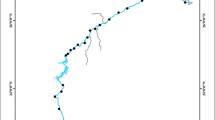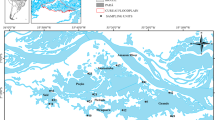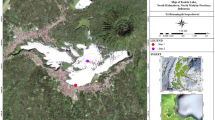Abstract
Ecological quality evaluations using diatoms, which are accepted as one of the biological quality components have accelerated recently in different basins of Türkiye. Asi Basin which has a small catchment area within the borders of Türkiye, located near to Syrian border and is under the influence of a Mediterranean climate. This study aims to determine the water quality of the streams in this basin by using various diatom indices and to determine the environmental pressures affecting the diatom community structure. In this study, 21 rivers of the Asi Basin were sampled three times during 2019 to evaluate their ecological status by using 18 different diatom indices. A total of 157 diatom taxa were recorded in these rivers. Different environmental variables were also sampled combined with diatoms, and according to RDA, alkalinity (ALK), electrical conductivity (EC), total phosphorus (TP), and total nitrogen (TN) were determined as the most decisive pressures for the distribution of diatom assemblages. In terms of TN, Bayrak River (R7), while in terms of TP, Üçocak River (R12) have II. class water quality. The eight diatom indices showed significant correlations with TP (p < 0.01). The Trophic-Saprobic index (LOBO) showed the highest response to the TP (R2 = 0.63) and was consistent with the indicator species. This index was also compatible with the evaluation results made according to the water quality classes of the sites. LOBO index classified these rivers as high-good or poor-bad effectively in terms of TP. It was the first time that the LOBO which was developed to evaluate the surface freshwaters of Brazil has a high correlation with TP in a basin of Türkiye.






Similar content being viewed by others
Data availability
Not applicable.
Code availability
Not applicable.
References
APHA, American Public Health Association (2012) Standard methods for the examination of water and wastewater. American water works association, water environment federation, 22nd edn. Washington D.C. https://doi.org/10.1100/2012/462467
Atazadeh I, Sharifi M, Kelly MG (2007) Evaluation of the trophic diatom index for assessing water quality in river Gharasou, western Iran. Hydrobiologia 589:165–173. https://doi.org/10.1007/s10750-007-0736-0
Baattrup-Pedersen A, Johnsen TJ, Larsen SE, Riis T (2022) Alkalinity and diatom assemblages in lowland streams: how to separate alkalinity from inorganic phosphorus in ecological assessments? Sci Total Environ 823:153829. https://doi.org/10.1016/j.scitotenv.2022.153829
Bąk M, Witkowski A, Żelazna-Wieczorek J, Wojtal AZ, Szczepocka E, Szulc K, Szulc B (2012) The key for the determination of diatoms in phytobenthos for the purpose of assessing the ecological status of surface waters in Poland. Environmental Monitoring Library, Warsaw
Bere T, Tundisi JG (2009) Weighted average regression and calibration of conductivity and pH of benthic diatom assemblages in streams influenced by urban pollution–São Carlos/SP, Brazil. Acta Limnol Bras 21(3):317–325
Çelekli A, Lekesiz Ö (2020) Eco-assessment of West Mediterranean basin's rivers (Turkey) using diatom metrics and multivariate approaches. Environ Sci Pollut Res 27:27796–27806. https://doi.org/10.1007/s11356-020-09140-1
Çelekli A, Toudjani AA, Gümüş EY, Kayhan S, Lekesiz HÖ, Çetin T (2019a) Determination of trophic weight and indicator values of diatoms in Turkish running waters for water quality assessment. Turk J Bot 43:90–101. https://doi.org/10.3906/bot-1704-40
Çelekli A, Kayhan S, Lekesiz Ö, Toudjani AA, Çetin T (2019b) Limno-ecological assessment of Aras River surface waters in Turkey: application of diatom indices. Environ Sci Pollut Res 26:8028–8038. https://doi.org/10.1007/s11356-019-04295-y
Çelekli A, Lekesiz Ö, Çetin T (2022) Eco-assessment of least disturbed areas of the Antalya River basin: application of diatom indices from different ecoregions. Environ Sci Pollut Res 29:790–804. https://doi.org/10.1007/s11356-021-15394-0
Cemagref (1982) Etude des méthods biologiques quantitatives d'appréciation de la qualité des eaux. Rapport Division. A.F.B., Rhȏne-Mediterranee-Corse, Lyon
Çetin T, Demir N (2019) The use of phytobenthos for the ecological status assessment in upper Sakarya Basin, Turkey. Appl Ecol Env Res 17:10155–10172. https://doi.org/10.15666/aeer/1704_1015510172
Çetin T, Solak CN, Yılmaz E (2021) Testing the performance of European diatom indices for evaluating the ecological status in the Kızılırmak basin, Turkey: flowing waters. Environ Sci Pollut Res 28:43567–43578. https://doi.org/10.1007/s11356-021-13282-1
Clement R, Jensen E, Prioretti L, Maberly SC, Gontero B (2017) Diversity of CO2-concentrating mechanisms and responses to CO2 concentration in marine and freshwater diatoms. J Experimen Bot 68:3925–3935. https://doi.org/10.1093/jxb/erx035
Coste M, Boutry S, Tison-Rosebery J, Delmas F (2009) Improvements of the biological diatom index (BDI): description and efficiency of the new version (BDI-2006). Ecol Indic 9:621–650. https://doi.org/10.1016/j.ecolind.2008.06.003
Delgado C, Pardo I, García L (2010) A multimetric diatom index to assess the ecological status of coastal Galician rivers (NW Spain). Hydrobiologia 644:371–384. https://doi.org/10.1007/s10750-010-0206-y
Dell’Uomo A (2004) L’indice diatomico di eutrofizzazione/pollu-zione (EPI-D) nel monitoraggio delle acque correnti. Linee Guida. APAT Agency for Environmental Protection and Technical Services, Rome (in Italian)
Descy JP (1979) A new approach to water quality estimation using diatoms. Nowa Hedwigia 64:305–323
Descy JP, Coste M (1991) A test of methods for assessing water quality based on diatoms. Verhandlungen der Internationalen Vereinigung Für Theorestische und Angewandte Limnologie 24:2112–2116. https://doi.org/10.1080/03680770.1989.11899905
DGWM (Directorate General of Water Management) (2019a) Asi ve Seyhan Havzaları Taşkın Yönetim Planı Hazırlama Projesi, Asi Havzası Taşkın Yönetim Planı Stratejik Çevresel Değerlendirme Taslak Kapsam Belirleme Raporu, Ankara (in Turkish)
DGWM (Directorate General of Water Management) (2019b) Yer Üstü Suları, Yer Altı Suları ve Sedimentten Numune Alma ve Biyolojik Örnekleme Tebliği. Resmi Gazete, Sayı, 29274 (in Turkish)
DGWM (Directorate General of Water Management) (2021) Yerüstü Su Kalitesi Yönetmeliği - Kıtaiçi Yerüstü Su Kaynaklarının Genel Kimyasal ve Fizikokimyasal Parametreler Açısından Sınıflarına Göre Kalite Kriterleri. Resmi Gazete, Sayı, 31513 (in Turkish)
Dumnicka E, Jelonek M, Klich M, Kwandrans J, Wojtal A, Zurek R (2006) Ichtiofauna i status ekologiczny wód Wisły, Raby, Dunajca i Wisłoki (Ichthyofauna and ecological status of Vistula, Raba, Dunajec and Wisłoka Rivers). Institute of Nature Conservation, Polish Academy of Science, Kraków (in Polish)
Eloranta P, Soininen J (2002) Ecological status of some Finnish rivers evaluated using benthic diatom communities. J Appl Phycol 14:1–7
European Committee for Standardization (2010) Water quality— Guidance standard for the surveying, sampling and laboratory analyses of phytobenthos in shallow running water. European Standard EN, 15708, Brussels
European Union (2000) Directive 2000/60/EC of the European Parliament and of the Council of 23 October 2000 establishing a framework for community action in the feld of water policy. Of J Eur Commun L327:1–73
Gómez N, Licursi M (2001) The Pampean diatom index (IDP) for assessment of rivers and streams in Argentina. Aquat Ecol 35:173–181. https://doi.org/10.1023/A:1011415209445
Guiry MD, Guiry GM (2023) AlgaeBase. World-wide electronic publication. National University of Ireland, Galway. http://www.algaebase.org. Accessed 20 Jan 2023
Hürlimann J, Niederhauser P (2002) Méthode d’analyse et d’appréciation des cours d’eau en Suisse, Diatomées, niveau R région. Office fédéral de l’environnement, des forêts et du paysage OFEFP, Version provisoire du, Berne (in French)
Jiyenbekov A, Barinova S, Bigaliev A, Nurashov S, Sametova E, Fahima T (2018) Bioindication using diversity and ecology of algae of the Alakol Lake, Kazakhstan. Appl Ecol Environ Res 16:7799–7831. https://doi.org/10.15666/aeer/1606_77997831
Kalyoncu H, Çiçek NL, Akköz C, Yorulmaz B (2009) Comparative performance of diatom indices in aquatic pollution assessment. Afr J Agric Res 4:1032–1040
Karacaoğlu D, Dalkıran N (2017) Epilithic diatom assemblages and their relationships with environmental variables in the Nilüfer Stream Basin, Bursa, Turkey. Environ Monit Assess 189:1–22. https://doi.org/10.1007/s10661-017-5929-z
Karatas A, Korkmaz H (2012) Hatay Ilinin Su Potansiyeli ve Surdurulebilir Yonetimi. Mustafa Kemal Universitesi Yayinlari, No:40. Antakya
Kelly MG, Whitton BA (1995) The trophic diatom index: a new index for monitoring eutrophication in rivers. J Appl Phycol 7:433–444. https://doi.org/10.1007/BF00003802
Kelly M, Juggins S, Guthrie R, Pritchard S, Jamieson J, Rippey B, Hirst H, Yallop M (2008) Assessment of ecological status in UK rivers using diatoms. Freshw Biol 53:403–422. https://doi.org/10.1111/j.1365-2427.2007.01903.x
Kılıç E, Yücel N (2019) Determination of spatial and temporal changes in water quality at Asi River using multivariate statistical techniques. Turk J Fish Aquat Sci 19:727–737. https://doi.org/10.4194/1303-2712-v19_9_02
Krammer K (2000) Diatoms of Europe. In: Lange-Bertalot H (ed) The genus Pinnularia, vol 1. A.R.G. Gantner Verlag, Ruggell
Krammer K (2002) Diatoms of the European inland waters and comparable habitats, Cymbella, vol 3. A.R.G. Gantner Verlag, Ruggell
Krammer K (2003) Diatoms of Europe. Cymbopleura, Delicata, Navicymbula, Gomphocymbellopsis, Afrocymbella, vol 4. A.R.G. Gantner Verlag, Ruggell
Krammer K, Lange-Bertalot H (1986) Freshwater flora of Central Europe: Bacillariophyceae, I. Naviculaceae. Gustav Fischer Verlag, Stuttgart
Krammer K, Lange-Bertalot H (1991a) Freshwater flora of Central Europe: Bacillariophyceae. III. Centrales, Fragilariaceae, Eunoticeae. Gustav Fischer Verlag, Stuttgart
Krammer K, Lange-Bertalot H (1991b) Freshwater flora of Central Europe: Bacillariophyceae. IV. Achnanthaceae, critical additions to Navicula (Lineolatae) and Gomphonema. Gustav Fischer Verlag, Stuttgart
Krammer K, Lange-Bertalot H (1999) Freshwater flora of Central Europe: Bacillariophyceae. II. Epithemiaceae, Surirellaceae. Gustav Fischer Verlag, Stuttgart
Lange-Bertalot H (2001) Navicula sensu stricto 10 genera separated from Navicula sensu lato Frustulia. In: Lange-Bertalot H (ed) Diatoms of Europe - diatoms of the European inland waters and comparable habitats. Gantner Verlag, Ruggell
Lange-Bertalot H, Hofmann G, Werum M, Cantonati M, Kelly MG (2017) Freshwater benthic diatoms of Central Europe: over 800 common species used in ecological assessment (Vol. 942). Schmitten-Oberreifenberg, Koeltz Botanical Books, Germany
Leclercq L, Maquet B (1987) Deux nouveaux indices chimique et diatomique de qualite d'eau courante: application au Samson et a ses afuents (Bassin de la Meuse Belge), comparaison avec d'autres indices chimiques, biocenotiques et diatomiques. Inst Royal Sci Nat Belgique Doc Trav 38:1–113
Lecointe C, Coste M, Prygiel J (1993) “Omnidia”: software for taxonomy, calculation of diatom indices and inventories management. Hydrobiologia 269:509–513. https://doi.org/10.1007/BF00028048
Lobo EA, Callegaro VL (2000) Avaliação da qualidade de águas doces continentais com base em algas diatomáceas epilíticas: enfoque metodológico. Avaliação e Controle da Drenagem Urbana. Ed. Universidade/UFRGS, Porto Alegre, 558: 277–300. (in Portuguese)
Lobo E, Bes D, Tudesque L, Ector L (2004a) Water quality assessment of the Pardinho River, RS, Brazil, using epilithic diatom assemblages and faecal coliforms as biological indicators. Vie Milieu 54:115–125
Lobo EA, Callegaro VLM, Hermany G, Bes D, Wetzel CA et al (2004b) Use of epilithic diatoms as bioindicators from lotic systems in southern Brazil, with special emphasis on eutrophication. Acta Limnol Bras 16(1):25–40
Maberly SC (2014) The fitness of the environments of air and water for photosynthesis, growth, reproduction and dispersal of photoautotrophs: an evolutionary and biogeochemical perspective. Aquat Bot 118:4–13. https://doi.org/10.1016/j.aquabot.2014.06.014
Ongun-Sevindik T, Çetin T, Güzel U, Tunca H, Tekbaba AG (2023a) Using diatom indices to estimate the ecological status of minimally disturbed rivers of the Sakarya River basin (Türkiye). Ecohydrology 16(7):e2568. https://doi.org/10.1002/eco.2568
Ongun-Sevindik T, Çetin T, Tunca H, Güzel U, Tekbaba AG (2023b) Ecological status estimation of minimally disturbed rivers of the Akarçay Basin (Türkiye) using diatom indices. Biologia. https://doi.org/10.1007/s11756-023-01466-8
Ongun-Sevindik T, Çetin T, Tunca H, Güzel U, Tekbaba AG (2023c) Ecological status estimation of minimally disturbed rivers of the Western Mediterranean Basin (Türkiye) using diatom indices. Community Ecol 24:243–255. https://doi.org/10.1007/s42974-023-00147-5
Ongun-Sevindik T, Çetin T, Tekbaba AG, Güzel U, Yılmaz E (2023d) The distribution of diatom assemblages with the effects of environmental parameters and ecological status assessment based on diatom indices in the lentic systems of the Akarçay and Asi basins (Türkiye). Environ Monit Assess 195:1189. https://doi.org/10.1007/s10661-023-11840-3
Pérez L, Lorenschat J, Massaferro J, Pailles C, Sylvestre F et al (2013) Bioindicators of climate and trophic state in lowland and highland aquatic ecosystems of the northern Neotropics. Rev Biol Trop 61:603–644
Potapova M, Charles DF (2003) Distribution of benthic diatoms in US rivers in relation to conductivity and ionic composition. Freshw Biol 48(8):1311–1328
Prygiel J, Leveque L, Iserentant R (1996) IDP: a new practical diatomic index for the evaluation of water quality in a monitoring network. Revue des Sciences de I’eau 9:97–113
Rimet F (2012) Recent views on river pollution and diatoms. Hydrobiologia 683(1):1–24. https://doi.org/10.1007/s10750-011-0949-0
Rott E, Hofmann G, Pall K, Pfister P, Pipp E (1997) Indikationslisten für Aufwuchsalgen in Fließgewässern in Österreich. Teil 1: Saprobielle Indikation. Wasserwirtschaftskataster, Bundesministerium f. Land- und Forstwirtschaft, Wien (in German)
Rott E, Pipp E, Pfister P, Van Dam H, Ortler K et al (1999) Indikationslisten für Aufwuchsalgen. Teil 2: Trophieindikation und autökologische Anmerkungen. Wasserwirtschaftskataster, Bundesministerium f. Land- und Forstwirtschaft, Wien (in German)
Rumeau A, Coste M (1988) Introduction into the systematics of freshwater diatoms. Bull Fr Piscic 309:1–69
Salomoni SE, Rocha O, Callegaro VL, Lobo EA (2006) Epilithic diatoms as indicators of water quality in the Gravataí river, Rio Grande do Sul, Brazil. Hydrobiologia 559:233–246
Şen B, Alp MT, Özrenk F (1997) Asi Nehri (Hatay)‘nin Akdeniz’e döküldügü kesimdeki diyatomlar (Bacillariophyta) üzerine bir araştırma. XIII. Ulusal Biyoloji Kongresi,. İstanbul, p 256–265 (in Turkish)
Sevindik TO, Kucuk F (2016) Benthic diatoms as indicators of water quality in the Acarlar floodplain Forest (northern Turkey). Fresenius Environ Bull 25:4013–4025
Sevindik TO, Alemdar E, Uzun A, Coşkun T, Tunca H (2021) Ecological status estimation of eight creeks in the Lake Sapanca Basin (Sakarya, Turkey) using diatom indices. Ann Limnol - Int J Lim 57:14. https://doi.org/10.1051/limn/2021012
Shen R, Ren H, Yu P, You Q, Pang W, Wang Q (2018) Benthic diatoms of the Ying River (Huaihe River basin, China) and their application in water trophic status assessment. Water 10:1013. https://doi.org/10.3390/w10081013
Sládeček V (1986) Diatoms as indicators of organic pollution. Acta Hydroch Hydrobiol 14:555–566. https://doi.org/10.1002/aheh.19860140519
Smol JP, Stoermer EF (2010) The diatoms: applications for the environment and earth sciences. Cambridge University Press, New York
Soeprobowati TR, Tandjung SD, Sutikno S, Hadisusanto S, Gell P (2016) The minimum number of valves for diatoms identıfıcatıon in Rawapening Lake, Central Java. Biotropia - Southeast Asian J Tropic Biol 23(2):97–100. https://doi.org/10.11598/btb.2016.23.2.486
Solak CN, Peszek Ł, Yılmaz E, Ergül HA, Kayal M et al (2020) Use of diatoms in monitoring the Sakarya River basin, Turkey. Water 12:703–723. https://doi.org/10.3390/w12030703
Steinberg C, Schiefele S (1988) Biological indication of trophy and pollution of running waters. Z Wasser Abwass For 21:227–234
Swift E (1967) Cleaning diatom frustules with ultraviolet radiation and peroxide 1. Phycologia 6:161–163
Taş B, Tepe Y, Ustaoğlu F, Alptekin S (2019) Benthic algal diversity and water quality evaluation by biological approach of Turnasuyu Creek, NE Turkey. Desalin Water Treat 155:402–415
Taşdemir M, Göksu ZL (2001) Asi Nehri'nin (Hatay, Türkiye) Bazı Su Kalite Özellikleri. Su Ürünleri Dergisi 18:55–64 (in Turkish)
Tepe Y, Çebi A (2019) Acrylamide in environmental water: a review on sources, exposure, and public health risks. Expos Health 11:3–12. https://doi.org/10.1007/s12403-017-0261-y
ter Braak CJ, Smilauer P (2012) Canoco reference manual and user’s guide: software for ordination, version 5.0. Microcomputer Power, Ithaca
Tokatlı C, Solak CN, Yılmaz E (2020a) Water quality assessment by means of bio-indication: a case study of ergene river using biological diatom index. Aquat Sci Engin 35(2):43–51. https://doi.org/10.26650/ASE2020646725
Tokatlı C, Solak CN, Yılmaz E, Atıcı T, Dayıoğlu H (2020b) Research into the epipelic diatoms of the Meriç and Tunca Rivers and the application of the biological diatom index in water quality assessment. Aquat Sci Engin 35(1):19–26. https://doi.org/10.26650/ASE2019555681
Toudjani AA, Celekli A, Gümüş EY, Kayhan S, Lekesiz HÖ, Çetin T (2017) A new diatom index to assess ecological quality of running waters: a case study of water bodies in western Anatolia. Ann Limnol - Int J Lim 53:333–343. https://doi.org/10.1051/limn/2017012
Van Dam H, Mertens A, Sinkeldam J (1994) A coded checklist and ecological indicator values of freshwater diatoms from the Netherlands. Neth J Aquat Ecol 28:117–133. https://doi.org/10.1007/BF02334251
Venkatachalapathy R, Karthikeyan P (2012) Environmental impact assessment of Cauvery river with diatoms at Bhavani, Tamil Nadu, India. Int J Geol Earth Environ Sci 2(3):36–42
Watanabe T, Asai K, Houki A (1990) Numerical simulation of organic pollution in flowing waters. In: Cheremisinoff PN (ed) Encyclopedia of environmental control technology, Hazardous waste containment and treatment, vol 4. Gulf Publishing Company, Houston, pp 251–284
Weilhoefer CL, Pan Y (2006) Diatom-based bioassessment in wetlands: how many samples do we need to characterize the diatom assemblage in a wetland adequately? Wetlands 26:793–802. https://doi.org/10.1672/0277-5212(2006)26[793:DBIWHM]2.0.CO;2
Yalçın-Özdilek Ş (2006) Preliminary data on the diet of Garra rufa (Cyprinidae) in the Asi Basin (Orontes), Turkey. Cybium 30:177–186
Yilmaz AB (2016) Water quality issues in the Asi River basin. In: Kibaroglu A, Jaubert R (eds) Water resources managment in the lower Asi-Orontes River basin: issues and opportunities. MEF University, Istanbul, pp 85–96
Yilmaz AB, Dogan M (2008) Heavy metals in water and in tissues of himri (Carasobarbus luteus) from Orontes (Asi) river, Turkey. Environ Monitoring Assess 144(1–3):437–444
Acknowledgments
This study has been prepared by using the data obtained within the scope of “Establishment of Reference Monitoring Network in Türkiye” (2017-2020) (Project number: 2011 K050400) carried out under the responsibility of the Ministry of Agriculture and Forestry, General Directorate of Water Management.
Funding
None.
Author information
Authors and Affiliations
Contributions
Tuğba ONGUN SEVİNDİK designed the experiments, conducted the field sampling, identified and counted the diatoms, analyzed the data, and wrote the text. Tolga ÇETİN participated in project management, designed the experiments and analyzed the data. Elif YILMAZ, Uğur GÜZEL, Hatice TUNCA and Ayşe Gül TEKBABA conducted the field sampling and data curation. All authors read and agreed to the published version of the manuscript.
Corresponding author
Ethics declarations
Ethics approval and consent to participate
Not applicable.
Consent for publication
Not applicable.
Conflicts of interest/Competing interests
The authors declare that they have no competing interests.
Additional information
Publisher’s note
Springer Nature remains neutral with regard to jurisdictional claims in published maps and institutional affiliations.
Supplementary Information
ESM 1
(DOCX 103 kb)
Rights and permissions
Springer Nature or its licensor (e.g. a society or other partner) holds exclusive rights to this article under a publishing agreement with the author(s) or other rightsholder(s); author self-archiving of the accepted manuscript version of this article is solely governed by the terms of such publishing agreement and applicable law.
About this article
Cite this article
Ongun Sevindik, T., Çetin, T., Yilmaz, E. et al. Assessment of running water quality in the Asi River Basin (Türkiye) using diatom indices. Biologia 79, 685–699 (2024). https://doi.org/10.1007/s11756-024-01602-y
Received:
Accepted:
Published:
Issue Date:
DOI: https://doi.org/10.1007/s11756-024-01602-y




